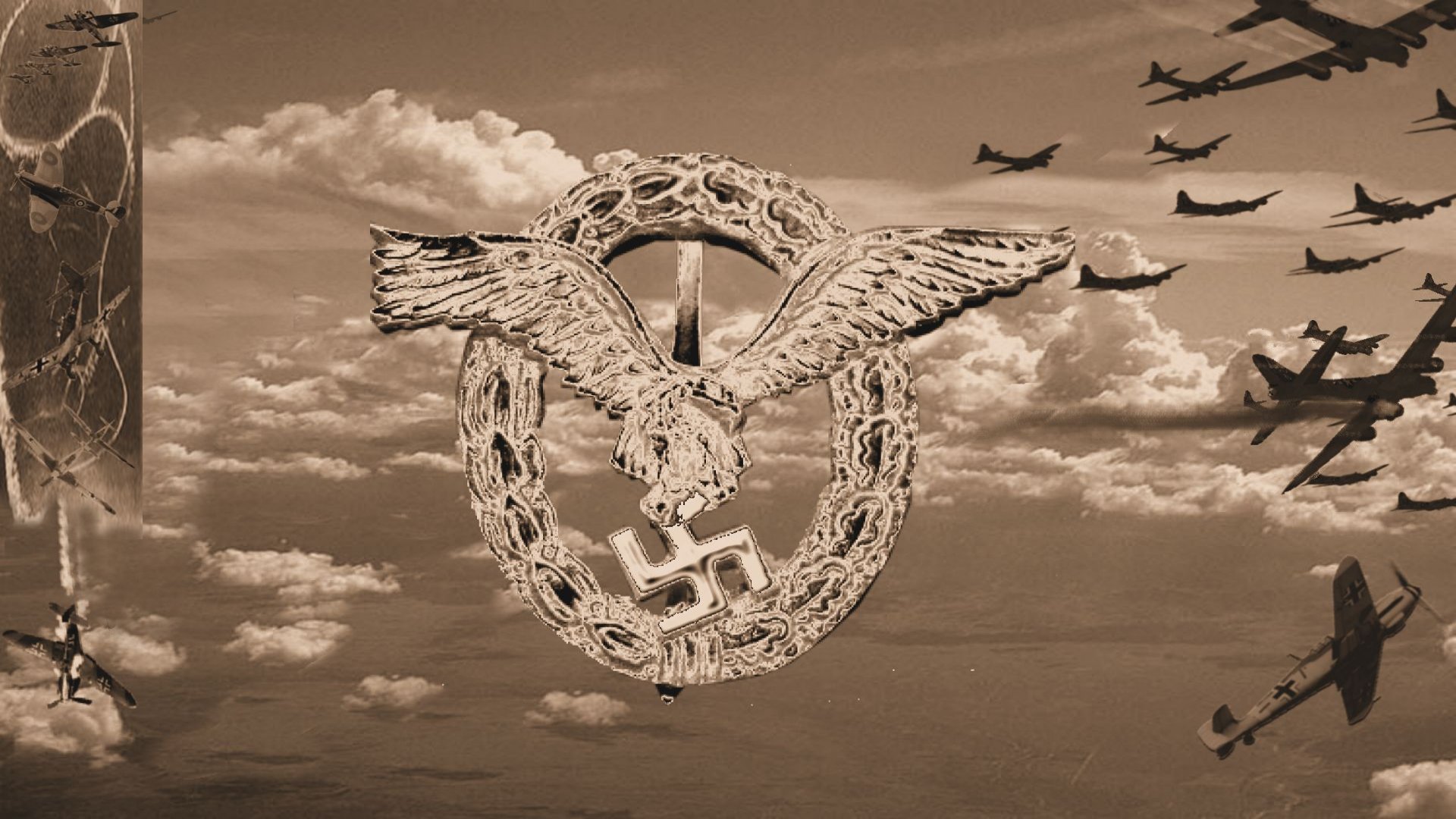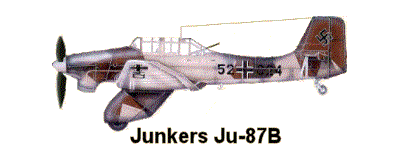The Junkers Ju87 or Stuka (from Sturzkampfflugzeug, meaning "dive bomber") was a two-man (pilot and rear gunner) German dive bomber and ground-attack aircraft. The aircraft was easily recognisable by its inverted gull wings, fixed spatted undercarriage and its infamous 'Jericho-Trompete' ('Jericho Trumpet') wailing siren, becoming the propaganda symbol of German air power and the blitzkrieg victories of 1939-1942.
Development
Designed by Hermann Pohlmann, the design of the Ju 87 had begun in 1933 as part of the Sturzbomber-Programm. The Ju 87 was to be powered by the British Rolls-Royce Kestrel engine and so ten engines were ordered by Junkers on 19 April 1934. The Ju 87 V1, powered by a Rolls-Royce Kestrel V12 cylinder liquid-cooled engine, and with a twin-tail, crashed on 24 January 1936 at Kleutsch near Dresden killing the test pilot and engineer. Generalfeldmarschall Wolfram von Richthofen told the Junkers representative and Construction Office chief engineer Ernst Zindel that the Ju 87 stood little chance of becoming the Luftwaffe's main dive bomber, as it was underpowered in his opinion. On 9 June 1936, the RLM ordered cessation of development in favour of the Heinkel He 118, a rival design, however Generalfeldmarschall Ernst Udet cancelled the order the next day, and development continued. After crashing the He 118 on the 27th of July 1936, Udet announced the Stuka the winner of the development contest. The Ju 87 could take off in just 250 m (820 ft) and climb to 1,875 m (6,152 ft) in just eight minutes with a 250 kg (550 lb) bomb load, and its cruising speed was 250 km/h (160 mph).
Back to Top
The Ju87's principal designer, held the opinion that any dive-bomber design needed to be simple and robust. This led to many technical innovations, such as the retractable undercarriage being discarded in favour of one of the Stuka's distinctive features, its fixed and "spatted" undercarriage. The Stuka's design included several innovative features, including automatic pull-up dive brakes under both wings to ensure that the aircraft recovered from its attack dive even if the pilot blacked out from the high acceleration. The Stuka's acceleration was progressive its fixed undercarriage provided by the dive brakes. Flight testing began on 14 August 1936. Subsequent testing and progress fell short of Richthofen's hopes, although the machine's speed was increased to 280 km/h (170 mph) at ground level and 290 km/h (180 mph) at 1,250 m (4,100 ft), while maintaining its good handling ability. Most dive bombers give their pilots the sensation of diving vertically but the Stuka did genuinely plummet earthwards at a true 90 degrees angle. Indicator marks on the starboard side of the cockpit side screen ran from 30 to 90 degrees to enable the pilot to judge the angle correctly. From its level flight speed of 255 mph (410 km/h) the Stuka accelerated to 335 mph (540 km/h) as it dived some 4,500 ft (1,370 m).Its maximum permitted speed was 373 mph (600 km/h).
Back to Top
Major Variants
The Ju87B series was to be the first mass-produced variant. A total of six pre-production Ju87 B-0 were produced, built from Ju87 A airframes. Test flights began from the summer of 1937. A small number, at least three, served as conversion Cs or Es for potential naval variants. The first production version was the Ju87 B-1, with a considerably larger engine, its Junkers Jumo 211D generating 1,200 PS (883 kW, 1,184 hp), and completely redesigned fuselage and landing gear. This new design was again tested in Spain, and after proving its abilities there, production was ramped up to 60 per month. As a result, by the outbreak of World War II, the Luftwaffe had 336 Ju 87 B-1s on hand. The B-1 was also fitted with "Jericho trumpets", essentially propeller-driven sirens with a diameter of 0.7 m (2.3 ft) mounted on the wing's leading edge directly forward of the landing gear, or on the front edge of the fixed main gear fairing. This was used to weaken enemy morale and enhance the intimidation of dive-bombing. After the enemy became used to it, however, they were withdrawn. The devices caused a loss of some 20-25 km/h (10-20 mph) through drag. Instead, some bombs were fitted with whistles on the fin to produce the noise after release.
Back to Top
The Ju87D-series featured two coolant radiators underneath the inboard sections of the wings, while the oil cooler was relocated to the position formerly occupied by the coolant radiator. The D-series also introduced an aerodynamically refined cockpit with better visibility and space. In addition, armor protection was increased and a new dual-barrel 7.92 mm (.312 in) MG 81Z machine gun with an extremely high rate of fire was installed in the rear defensive position.
With the Ju87G variant, the aging airframe of the Ju87 found new life as an anti-tank aircraft. This was the final operational version of the Stuka, and was deployed on the Eastern Front. The reverse in German military fortunes after 1943 and the appearance of huge numbers of well-armoured Soviet tanks caused Junkers to adapt the existing design to combat this new threat. In April 1943, the first production Ju87 G-1s were delivered to front line units. The two 37 mm (1.46 in) cannons were mounted in under-wing gun pods, each loaded with a six-round magazine of armour-piercing tungsten carbide ammunition. With these weapons, the Kanonenvogel, as it was nicknamed, proved spectacularly successful in the hands of Stuka aces such as Hans-Ulrich Rudel(519 Tank Kills). The G-1 was converted from older D-series airframes, retaining the smaller wing, but without the dive brakes.
Back to Top
In Service
Spain
The Stuka first flew in 1935 and made its combat debut in 1936 as part of the Luftwaffe's Condor Legion during the Spanish Civil War. In the Spanish Civil War the Luftwaffe depolyed several Ju87's to support the Nationalists. In January 1938, three Ju87As arrived. Several problems became evident - the spatted undercarriage sank into muddy airfield surfaces, and the spats were temporarily removed. In addition, the maximum 500 kg (1,100 lb) bomb load could only be carried if the gunner vacated his seat, therefore the bomb load was restricted to 250 kg (550 lb). These aircraft carried out anti-shipping missions until they returned to Germany in October 1938. The A-1s were replaced by five Ju87B-1s, but by this stage the Civil war was almost over.
Back to Top
Blitzkreig
There were over 300 Stukas in service by the invasion of Poland and the performed well enough. But it was over France and the Low Countries in 1940 that they stunned the world. The British , French , Belgian and Dutch armies had more men and tanks then the Germans, but the Luftwaffe achieved air superiority. As the panzer divisions debouched from the Ardennes forest at Sedan , their way was barred by the French 9th Army. It was a weak formation but held the line of the Meuse with heavy guns ranged in on likely crossing points. The French artillery positions were wiped out and the German ground troops forced their way across. The Stukas were like flying artillery, but with far greater range and flexibility. They struck at Allied divisions behind the front catching French heavy tanks still on their railway cars. However, during the Battle of Britain, they were mauled by the RAF and were quickly withdrawn from combat. Despite the Stuka's vulnerability to enemy fighters having been exposed during the Battle of Britain, the Luftwaffe had no choice but to continue its development, as there was no replacement aircraft in sight.
Back to Top
Mediterranean
Limited numbers of Stukas served in North Africa and the Italian campaign, but it was the Balkans and the Mediterranean where the Stuka shone. Attacking convoys bound for Malta, in association with Regia Aeronautica Italiana, many Allied transports were sent to the bottom, as well as a number of warships. Stukas were effective as a dive bomber in the Mediterranean until the Allied landings at Tunisia in Operation Torch. After that, they were mauled again by the growing air superiority of the Allies.
Back to Top
Eastern Front
It was in Russia that the Stuka had its greatest impact. In 1941 the Soviet air force was effectively wiped out by the Luftwaffe and the 290 Stukas sent to the Eastern Front could attack without fear of interception. It was not until mid-1943 that German bombers were seriously menaced by Soviet fighters. Stukas continued to operate in large numbers, several hundred of them attacked the Soviet bridgehead near Novorossiysk in April 1943. The G version with its 30mm 'Kanonenvogel' ("cannon-bird") had a profound impact on Soviet armour. Capable of penetrating the armour of the heaviest Soviet tanks because of the angle of attacks, they could roam across the battlefield killing multiple targets. However, the rise in Soviet airpower from 1943 onwards limited the effective use of these Stukas.
Back to Top
Other Countries
Ju87 Stukas were supplied to allied air forces of Romania, Italy, Hungary and Bulgaria. Stuka production in one year peaked at 1,814 units. Some 5,700 of all variants were completed before production ceased in 1944.
Back to Top



